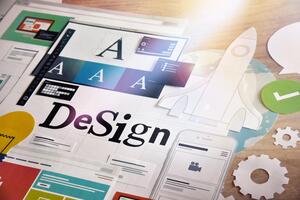Essential Graphic Design Principles Every Designer Should Know
Body
Graphic design is far more than just putting images and text together; it is a form of visual communication that blends creativity, psychology, and strategy. Whether you’re a budding designer, a marketing professional, or a business owner working with creatives, understanding the essential principles of graphic design can dramatically improve your ability to create (or evaluate) impactful visual content.
This article dives deep into the core graphic design principles that serve as the building blocks of all successful visual communication.
1. Balance
Balance refers to the visual weight distributed within a design. A well-balanced composition ensures that no part of the design overpowers the rest, creating harmony and professionalism.
There are two main types of balance:
-
Symmetrical balance, where elements are evenly distributed, often mirroring one another.
-
Asymmetrical balance, where different elements have equal visual weight without being identical.
Mastering balance helps make designs feel stable and intentional, especially in layouts like posters, web pages, and magazine spreads.
2. Contrast
Contrast is the difference between elements in a design. It helps to highlight the most important elements and creates visual interest.
Common ways to create contrast include:
-
Light vs. dark colors
-
Large vs. small sizes
-
Serif vs. sans-serif fonts
-
Bold vs. thin lines
Effective use of contrast improves readability and ensures that your design elements don’t blur together.
3. Alignment
Alignment ensures that elements are visually connected. Good alignment provides order, sharpness, and clarity, especially in layouts with lots of text or repeated patterns.
There are four common types of alignment:
-
Left
-
Right
-
Center
-
Justified
Using a consistent alignment grid ensures professional-quality results, especially in brand collateral and digital marketing.
4. Proximity
Proximity refers to the grouping of related elements. When items are close to one another, they appear to be part of the same group—even if they aren’t physically connected.
Good use of proximity:
-
Reduces clutter
-
Improves organization
-
Makes content more scannable
For example, in a business card, the name, title, and contact information should be placed near each other to indicate their connection.
5. Repetition
Repetition creates a sense of unity and consistency. By repeating design elements like colors, shapes, fonts, or patterns, you strengthen the visual identity of your design.
Repetition is especially important in branding. Think of a brochure where the same font, color scheme, and icons are repeated throughout to create cohesion.
6. Hierarchy
Visual hierarchy is about directing the viewer’s eye to the most important parts of your design first. It’s often achieved through variations in size, color, weight, or placement.
For example:
-
Headlines are larger and bolder than body text.
-
Call-to-action buttons stand out using bold colors or borders.
Hierarchy ensures that your message is not only noticed but also understood in the right order.
7. White Space (Negative Space)
White space is the empty area between elements. It's not just "blank" space—it's an essential part of any design that helps improve focus, readability, and elegance.
When used effectively, white space:
-
Prevents clutter
-
Improves content flow
-
Gives designs a clean, modern look
Think of logos like Apple or Google—simplicity and space enhance their recognizability and impact.
8. Color Theory
Color plays a powerful emotional and psychological role in design. Understanding color theory allows designers to choose palettes that resonate with their target audience and align with brand values.
Some common color rules:
-
Complementary colors (opposite each other on the color wheel) create dynamic contrast.
-
Analogous colors (next to each other on the wheel) offer harmony and smooth transitions.
-
Monochromatic palettes rely on tints and shades of a single hue for subtle elegance.
A brand using consistent color theory enhances recognition and evokes the desired emotional response.
9. Typography
Typography involves the arrangement and style of text in a design. The right typeface sets the tone, improves readability, and strengthens the brand voice.
Key considerations:
-
Font pairing: Use contrasting fonts for headings and body text that still complement each other.
-
Readability: Ensure text size and spacing are comfortable to read on all devices.
-
Hierarchy: Use different font weights and sizes to guide the reader through your content.
Well-executed typography can elevate a design from good to exceptional.
10. Consistency
Consistency ties all the principles together. A consistent design approach ensures your audience receives a clear and unified message every time.
Consistency in:
-
Layout and spacing
-
Typography and color use
-
Icon styles and imagery
…creates a strong, cohesive brand identity that is both memorable and professional.
Applying These Principles in the Real World
Whether you're creating a logo, website layout, packaging design, or a social media post, these principles provide the foundation for high-quality, effective design.
If you’re looking to bring these principles to life in your branding or marketing, consider hiring an experienced agency for graphic design that understands how to apply these concepts strategically and creatively.
Conclusion
Graphic design is both an art and a science. Mastering the foundational principles—from balance and contrast to typography and consistency—empowers you to create visuals that not only look good but also communicate effectively.
Whether you're a solo designer, part of a creative team, or someone hiring design services, understanding these principles will enhance your ability to recognize good design and deliver visual messages that resonate with your audience.







Comments